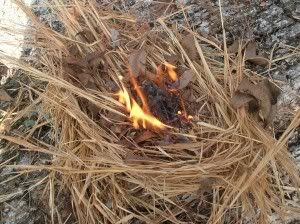
Click title or picture for full article.
Tinder and Kindling

We have covered the importance of fire in a survival situation. Proper preparation of tinder is the foundation of starting a fire. There is nothing more frustrating than to finally get a coal or a fire started only to have it go out from lack of tinder preparation. In order for a material to burn, it needs to reach the proper ignition temperature. The ignition temperature will be affected by things such as moisture within the material, the density of the material, and for survival purposes, how well you prepare the material (shredding or cutting of the material). In other words the size of the fuel source matters. Fine materials such as cotton balls ignite with ease while larger objects must be added after the kindling has been burning for some time.
Tinder -
Tinder is a material that is easily ignited. We prefer to think of it as a combustible material that will ignite with a small spark. Why, because we are nature lovers, hikers, campers, hunters, and fishermen. In case of a survival situation, we want to know what materials will allow us to create a fire.
This is where I realized, some materials are good starter fuel and some are good tinder. What does this mean to us? Some materials will ignite at the slightest spark while others are readily combustible after the flame is present. We use kindling to keep the fire going after the flame is present.
Examples of tinder: Real cotton balls, the slightest spark will ignite into a flame. Other examples of tinder are dry grass, Cattail fluff, Birch tree bark and Dandelion clock.
Examples of kindling: Cedar bark, dry leaves of any type and small twigs. Kindling is just as important as tinder. Do not go through the trouble of starting the fire and using up your tinder only to have the fire go out. Have plenty of kindling next to you. Save some for later inside your shelter if possible.
Some kindling can be used as tinder if properly prepared. By cutting and shredding materials they become thinner and more able to ignite with a simple spark.
The following article covers tips on starting fire in adverse weather:
We can think of this in a three stage process:
1) Tinder - materials which will readily ignite with a spark.
2) Kindling - Small pieces of grass, leaves and twigs
3) Wood - Sustaining fuel. (gradually increase the size of the wood)
Note: You can use a branch / stick and create great tinder by using your knife. Start by removing the bark from the branch. This will help us get to the dry heartwood. Run the knife away from you to create a head of thin wooden curls. We can also stabilize the knife and pull the stick instead. These sticks are called feather sticks or fuzz sticks.
Fuzz Sticks / Feather Sticks
Fuzz sticks are a great way to start and keep a fire alive. We can remove the damp bark by using our knife edge. By cutting thing slices our of the wood, we can get to drier wood. The thinner slices will burn more readily. This will minimize heat loss by having to dry the wet bark.
There is nothing more frustrating and possibly dangerous than putting in the effort to start a fire only to have it extinguish. Proper planning and tinder/kindling choices are crucial.
Here is one example of a fuzz stick or feather stick.

My first experience with fire starting training was the bow and drill. When using the bow and drill you will only get a hot coal. The coal must be placed in what I like to call a "tinder nest". You then blow on the coal slowly until a flame is created.

Regardless of what we are using to start the fire, this is a good mentality. People have failed miserably at starting a fire with matches. Do not underestimate proper preparation of your tinder base.
TINDER
Practice makes perfect they say. The more you practice fire starting methods, the easier it will be for you to pick materials for tinder. You will start to get an idea for what works.
Materials that make great tender around the house will give you a good idea of what to use in wilderness. Pure cotton balls can ignite with a small spark. In North Carolina, I found a plant that has the same texture as cotton. I am still trying to find the name of this plant:
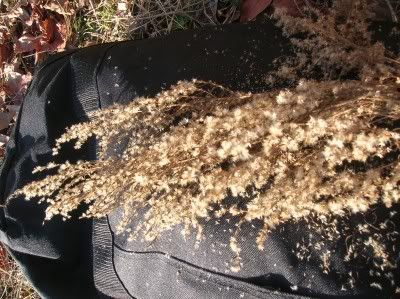
Materials that can be carried for tinder and kindling:
Natural Materials:
* Dry grass
* Leaves
* Shaved bark
* Dandelion head (clock)
* Birch bark
* Cattail fluff
* Cattail leaves dry
* Dry pine needles
* Fat Lighter or Fat wood
* Tinder fungus
* Punk wood
* Poplar Cotton
Note: Jute twine is flammable. If you take the time to separate the cord fibers it will readily catch a spark.





Dandelion clock


The very thin lint like material of the dandelion clock is an excellent fire starter. First we make a nest our of dry grass, then we place the dandelion clock in the center. Using a ferrocerium rod we are able to start a fire with two strokes.
Birch tree bark


Cattail fluff
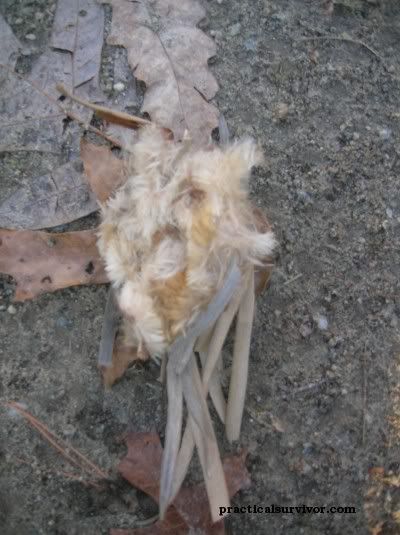
From my experience, you can easily start several fires with one cattail head. The fluff is very compact and ignites easily.
However, it burns so fast that if the tinder is not properly prepared, it will not start a fire.
Here I use the BlastMatch from Ultimate Survival Technologies. The tinder is a mix of cattail leaves and fluff. The first strike ignites the tinder, but it burns out quickly. Pardon the blurry picture but I had to take it quickly.
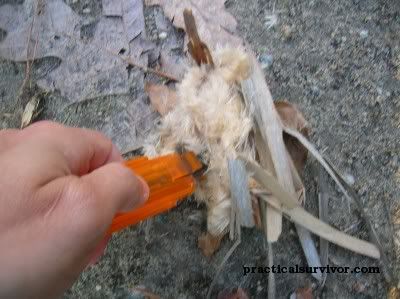
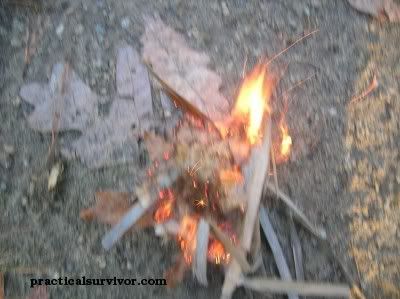
This is what I was left with. Not exactly what you want to see on a cold day.
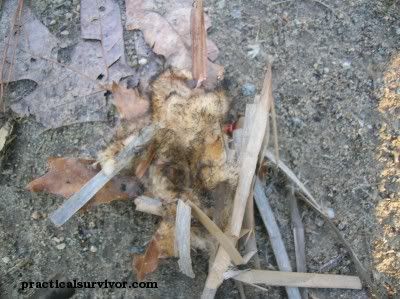
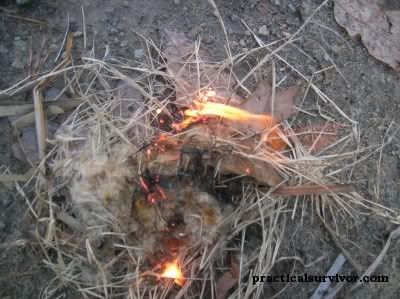
Dry grass is always great for fire starting so, I added some and the fire started without a problem.
Fat lighter or Fat wood
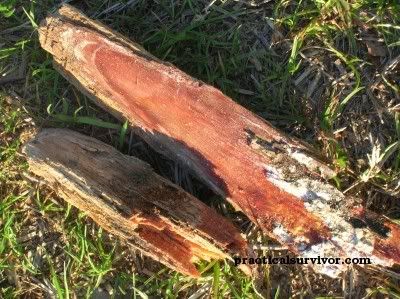
Called by many names:
* fat lighter
* fat wood
* lighter wood ( light wood )
Fat lighter is pine wood saturated in pitch or resin. Usually found in the pine tree stumps. Whether backpacking or in a survival situation fat wood will simplify starting your fire. It can be used both as tinder and kindling.
We can find the fat lighter wood in the tree stump of some pine trees. Fat lighter or fat wood is sold in stick form or dust form by different suppliers. Under damp conditions, fat lighter wood will help you to start a fire and sustain the flame.
Fat wood shavings can be ignited with the use of a sparker type fire starter. The flint rod from your magnesium block, a regular ferrocerium rod like the ones found in blastmatch, swedish firesteel, or strike force.
Obviously the fat lighter sticks
Please see our fat lighter article:
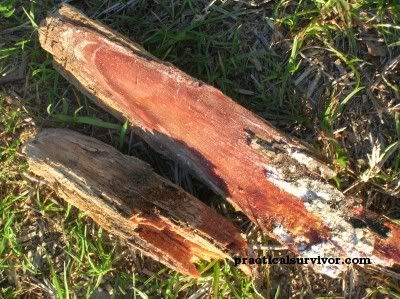
Click title or picture for full article.
Man made materials
* Cotton balls
* Lint from the clothes dryer
* Paper
* Tampons (cotton)
* Steel wool #0000
* Lint from your cotton socks
* Bicycle inner tube rings
* Pieces of vehicle tire
Experiment, get creative.
Cotton ball
The slightest spark will ignite both cotton balls and dryer lint.
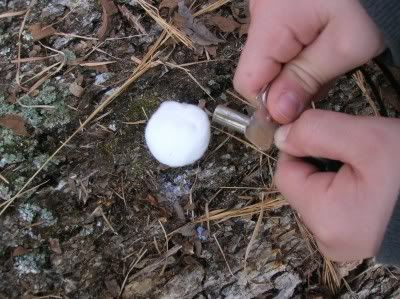
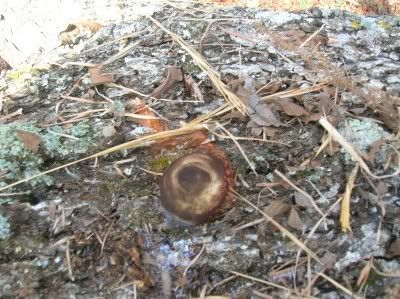
With one spark from the Swedish Fire Steel the cotton ignites.
Tampon cotton
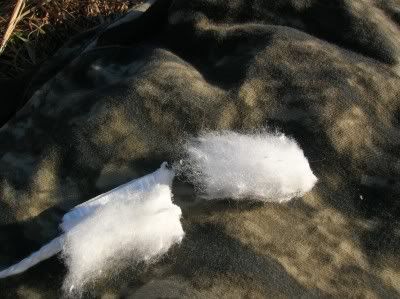
Steel Wool
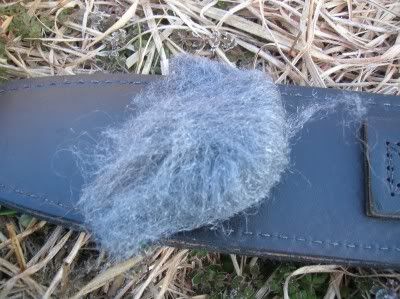
Fuel type materials:
* Trioxane bars
* Cotton balls - they can be covered in petroleum jelly (petrolatum) for damp conditions (petroleum)
* Sanitizing wipes - (70 % alcohol)
* Hexamin tablets (Esbit)
* Maya sticks and dust
* Fire paste
* Fire sticks (Coghlan's, Sure lite)
* Wetfire tinder (Survival Inc.)
* Fire starter squares (Safe lite)
* Tinder-quik (four seasons survival)
Trioxane

Use your knife and cut the Trioxane bar into a fine dust.
Sanitizing wipe
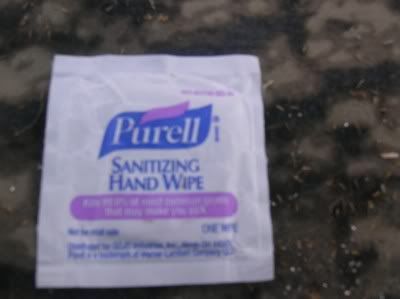
Depending on the percentage of alcohol on the wipe, we can usually ignite the wipe with spark from a striker type firestarter. If not, the wipe still helps to keep the fire started.
Fire Starter Squares
Firestarter squares by Safe lite. We found them at the local department store next to the fire logs and other fireplace materials. Made of compressed wood chips and wax. Supposed to burn for 8-12 minutes. We will time them soon. So far we tested them by using our knife to make a fine dust. Ignition with a ferrocerium rod was effortless.

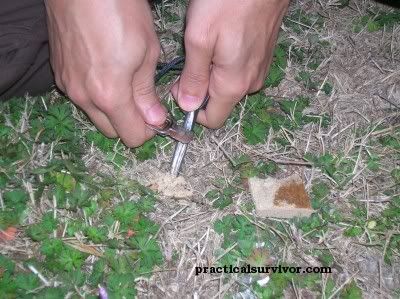
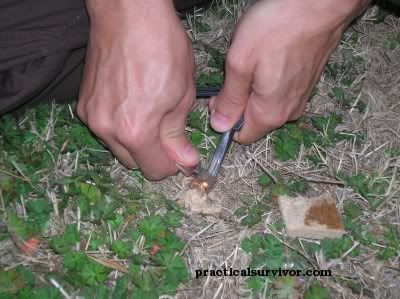

Maya sticks and maya dust
Made from fatwood pine (pino de ocote) from Guatemala and Mexico
They have a high percentage of resin 80% and are supposed to be easy to light in the rain.
It comes in stick form and dust. When attempting to start a fire under damp conditions, having fatwood is very useful. Backpackers like to carry the Maya sticks to assist in fire making. It takes less preparation time when the tinder has a high level of resin and will burn with a strong flame. An equivalent to the Maya Sticks can be made by splitting fatwood/fatlighter wood into sticks.
PLEASE READ OUR FATWOOD or FATLIGHTER ARTICLE BELOW

Click title or picture for full article.
Fire paste
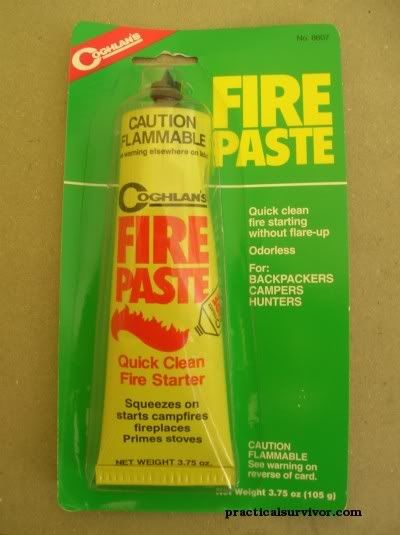
Wetfire
Wetfire tinder from ultimate survival is water proof will burn in water. Here we cut it into a fine dust after soaking it with water. A few sparks from a ferocerrium rod and it ignites.


It is always a good idea to carry a waterproof canister with dry tinder. Some items we use are:
* 35mm film canister
* Nalgene bottle
* Prescription medicine bottle
* zip loc bag
TIPS:
When attempting to create the spark, I found that putting the rod almost under the tinder works best. You want to point the rod towards the material you are attempting to ignite. It does not matter if its trioxane, magnesium, or just dry tinder. You aim the spark correctly and save yourself a lot of headache. If the tinder is damp, you can strike several times in quick motion and it helps to dry the tinder and increase the chances of fire.


practicalsurvivor.com by Robert Munilla is licensed under a Creative Commons Attribution-Noncommercial-No Derivative Works 3.0 Unported License.
